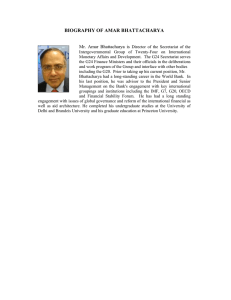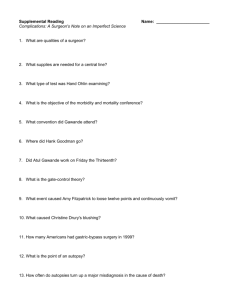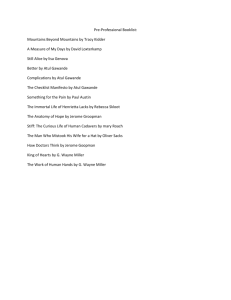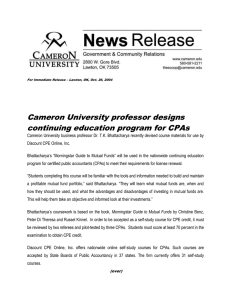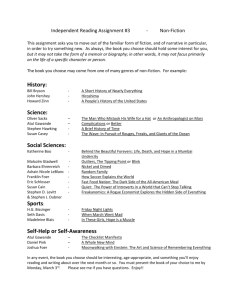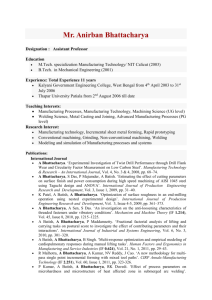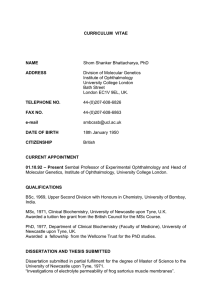Fall 2015 - La Follette School of Public Affairs
advertisement
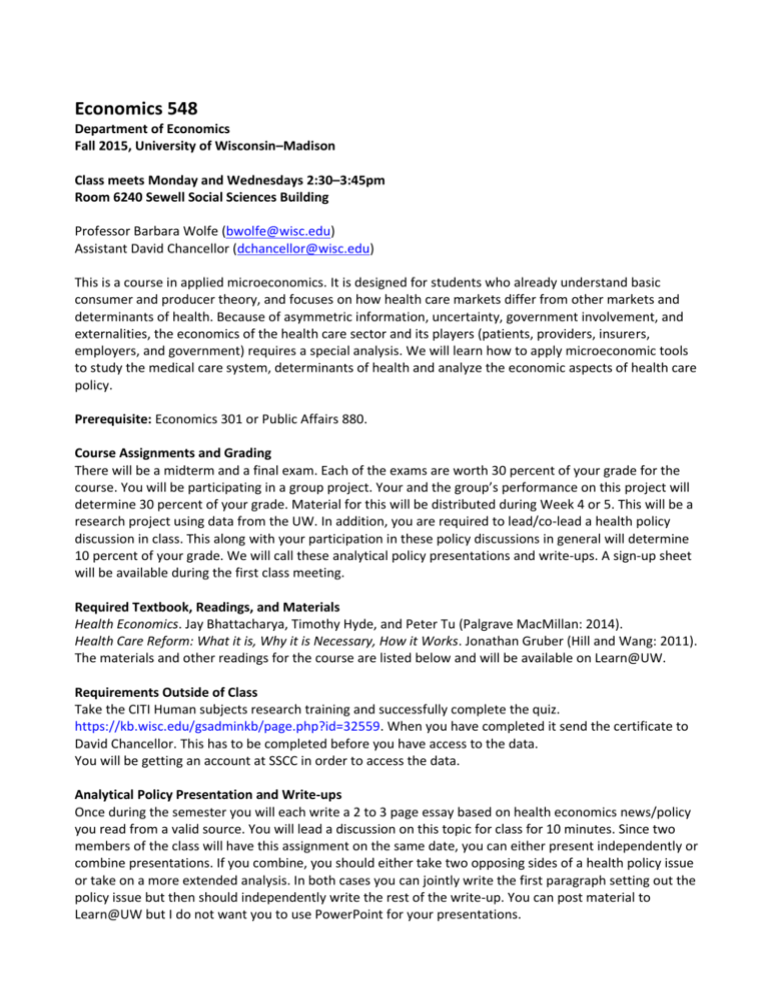
Economics 548 Department of Economics Fall 2015, University of Wisconsin–Madison Class meets Monday and Wednesdays 2:30–3:45pm Room 6240 Sewell Social Sciences Building Professor Barbara Wolfe (bwolfe@wisc.edu) Assistant David Chancellor (dchancellor@wisc.edu) This is a course in applied microeconomics. It is designed for students who already understand basic consumer and producer theory, and focuses on how health care markets differ from other markets and determinants of health. Because of asymmetric information, uncertainty, government involvement, and externalities, the economics of the health care sector and its players (patients, providers, insurers, employers, and government) requires a special analysis. We will learn how to apply microeconomic tools to study the medical care system, determinants of health and analyze the economic aspects of health care policy. Prerequisite: Economics 301 or Public Affairs 880. Course Assignments and Grading There will be a midterm and a final exam. Each of the exams are worth 30 percent of your grade for the course. You will be participating in a group project. Your and the group’s performance on this project will determine 30 percent of your grade. Material for this will be distributed during Week 4 or 5. This will be a research project using data from the UW. In addition, you are required to lead/co-lead a health policy discussion in class. This along with your participation in these policy discussions in general will determine 10 percent of your grade. We will call these analytical policy presentations and write-ups. A sign-up sheet will be available during the first class meeting. Required Textbook, Readings, and Materials Health Economics. Jay Bhattacharya, Timothy Hyde, and Peter Tu (Palgrave MacMillan: 2014). Health Care Reform: What it is, Why it is Necessary, How it Works. Jonathan Gruber (Hill and Wang: 2011). The materials and other readings for the course are listed below and will be available on Learn@UW. Requirements Outside of Class Take the CITI Human subjects research training and successfully complete the quiz. https://kb.wisc.edu/gsadminkb/page.php?id=32559. When you have completed it send the certificate to David Chancellor. This has to be completed before you have access to the data. You will be getting an account at SSCC in order to access the data. Analytical Policy Presentation and Write-ups Once during the semester you will each write a 2 to 3 page essay based on health economics news/policy you read from a valid source. You will lead a discussion on this topic for class for 10 minutes. Since two members of the class will have this assignment on the same date, you can either present independently or combine presentations. If you combine, you should either take two opposing sides of a health policy issue or take on a more extended analysis. In both cases you can jointly write the first paragraph setting out the policy issue but then should independently write the rest of the write-up. You can post material to Learn@UW but I do not want you to use PowerPoint for your presentations. Course Outline and Reading Assignments Week 1 9/2 Course Overview Week 2 9/9 Demand for Health and Health Care Bhattacharya, Chapters 1 and 2 Week 3 9/14 Demand for Health and Health care: The Grossman Model Bhattacharya, Chapter 3 Atul Gawande. June 1, 2009. “The Cost Conundrum,” The New Yorker. http://www.newyorker.com/reporting/2009/06/01/090601fa_fact_gawande?currentPage=all Atul Gawande. June 23, 2009. “The Cost Conundrum Redux,” The New Yorker. http://www.newyorker.com/online/blogs/newsdesk/2009/06/atul-gawande-the-cost-conundrumredux.html 9/16 Disparities in Health Bhattacharya, Chapter 4 Wm. Evans, B. Wolfe and N. Adler. 2012. “The SES and Health Gradient: A Brief Review of the Literature. Chp. 1 in Wolfe, Evans and Seeman, The Biological Consequences of Socio-Economic Inequalities. Pp 1-22. Week 4 9/21 Delivery of Health Care: The Labor Market for Physicians Bhattacharya, Chapter 5 Kane, Leslie & Carol Peckham. 2014. “Residents Salary and Debt Report.” Slide presentation. Medscape. (August 5). http://www.medscape.com/features/slideshow/public/residents-salary-and-debt-report 9/23 Delivery of Health Care: The Hospital Industry Bhattacharya, Chapter 6 (Emily Walden) Week 5 9/28 Demand for Insurance Part 1: Expected Utility Bhattacharya, Chapter 7 9/30 Demand for Insurance Part 2: Adverse Selection Bhattacharya, Chapter 8, Intro, 8.1, 8.3, and 9.11 Week 6 10/5 Demand for Insurance 3: Decision-Making and STATA. Abaluck & Gruber. 2011. “Choice Inconsistencies among the Elderly: Evidence from Plan Choice in the Medicare Part D Program,” American Economic Review 101 (June): 1180–1210. Introduction only. http://www.aeaweb.org/articles.php?doi=10.1257/aer.101.4.1180 It’s Your Choice 2015: Decision Guide State of Wisconsin Group Health Insurance Program for State of Wisconsin Employees, Retired State of Wisconsin Employees (Annuitants), Members with Continuation Coverage (Continuants), UW Graduate Assistants. Assignment: Go over this and pick one plan that you prefer from all options for any one of the options (State employee, UW Graduate Assistant, etc.). Write 3-4 reasons you selected this plan. Post it in the discussion section for the course on UWLearn. Most of this class may be devoted to an introduction to Stata for those not familiar with it. 10/7 Moral Hazard Gladwell, M. 2005. “The Moral-Hazard Myth,” The New Yorker, August 29. http://www.newyorker.com/archive/2005/08/29/050829fa_fact?currentPage=all Bhattacharya, Chapter 11. Week 7 10/12, 10/14 The American Model & Public Sector Programs Bhattacharya, Chapter 18 Moon, Marilyn. 2001. "Medicare," The New England Journal of Medicine 344(12): 928–931. Wolfe, Barbara. 2013. “Health Programs for Non-Elderly Adults and Children,” Chapter 9 in Legacies of the War on Poverty. (Russell Sage Foundation). Epstein, A. M. et al. 2014. “Analysis of Early Accountable Care Organizations Defines Patient, Structural, Cost, and Quality-Of-Care Characteristics,” Health Affairs 33(1): 95–102. Week 8 10/19 Midterm exam--material up through 10/14 10/21 The Affordable Care Act: Part I. Robert Haveman & Barbara Wolfe, 2010. "US Health Care Reform: A Primer and an Assessment," CESifo DICE Report, Ifo Institute for Economic Research at the University of Munich, 8(3), pages 53-60, October http://files.kff.org/attachment/fact-sheet-summary-of-the-affordable-care-act Gruber, J. 2011. Health Care Reform: What it is, Why it is Necessary, How it Works, Chapters 1-6. Week 9 10/26 The Affordable Care Act: Part II Gruber, J. 2011. Health Care Reform: What it is, Why it is Necessary, How it Works, Chapters 7-12. Pollak, Harold. 2013. “30 Economists: We Need Individual Mandate.” (July 18). http://www.healthinsurance.org/blog/2013/07/18/30-economists-we-need-the-individual-manda te/ “Risk Adjustment in Health Insurance,” Health Affairs Health Policy Brief. (August 30, 2012). http://healthaffairs.org/healthpolicybriefs/brief_pdfs/healthpolicybrief_74.pdf. “Young, Fit, and Uninterested,” The Economist. (January 18, 2014). http://www.economist.com/news/united-states/21594300-was-supposed-be-month-uninsured-g ot-health-insurance-not-enough. 10/28 The Affordable Care Act: Part III Current Evidence of effects. Sommers, B.D., T. Buchmuller, S.L. Decker, C. Carey, and R. Kronick. 2013. "The Affordable Care Act Has Led to Significant Gains in Health Insurance And Access to Care for Young Adults". Health Affairs 32(1). 165-74. Polsky, Daniel, Michael Richards, Simon Basseyn, Douglas Wissoker, Genevieve M. Kenney, Stephen Zuckerman, and Karin V. Rhodes. 2015. "Appointment Availability after Increases in Medicaid Payments for Primary Care." New England Journal of Medicine 372(6): 537-545. Lau, Josephine S., Sally H. Adams, M. Jane Park, W. John Boscardin, and Charles E. Irwin, Jr. 2014. "Improvement in Preventive Care of Yount Adults After the Affordable Care Act: The Affordable Care Act is Helping." JAMA Pediatrics 168(12): 1101-1106. Week 10 11/2 Why are Costs So High? Population Aging Bhattacharya, Chapter 19 11/4 Why are Costs so High? Physician Decision Making, Organizational Management, and Efficiency Gawande, Atul. 2012. “Big Med,” The New Yorker. (August) http://www.newyorker.com/reporting/2012/08/13/120813fa_fact_gawande?currentPage=all Gawande, Atul. 2007. “The Checklist,” New Yorker, (December 10). http://www.newyorker.com/reporting/2007/12/10/071210fa_fact_gawande?currentPage=all Cutler, David. 2013. “Where Are the Health Care Entrepreneurs?” Issues in Science and Technology. November. Week 11 11/9 Pharmaceutical Markets and Innovations Bhattacharya, Chapter 12, beginning through section 12.3 11/11 (Professor David Vanness) Bhattacharya, Rest of Chapter 12. D. Lakdawalla et al. 2009. “US Pharmaceutical Policy in a Global Marketplace,” Health Affairs 28(1): w138–w150. Week 12 11/16 International Health Care Systems and Alternative Designs Bhattacharya Chapter 15 11/18 International Health Care Systems and Alternative Designs, continued. Bhattacharya, Chapters 16-17. Weeks 13–15: November 23, 25, 30; December 2 and 7: Group Presentations Week 15 (Final Reports from Groups due 12/9 by beginning of class). 12/9 International Health Systems and Comparisons to the US Cutler, D., & D Ly. 2011. “The (Paper)Work of Medicine: Understanding International Medical Costs,” Journal of Economic Perspectives 25(2, Spring): 3–25. Davis, Karen, Kristof Stremikis, David Squires, and Cathy Schoen. 2014. “Mirror, Mirror on the Wall: How the Performance of the US Health Care System Compares Internationally.” http://www.commonwealthfund.org/~/media/files/publications/fund-report/2014/jun/1755_davi s_mirror_mirror_2014.pdf Week 16 12/14 Course Wrap Up: Health Economics and Policy: Past, Present and Future. Grievance Procedure The Department of Economics has developed a grievance procedure through which you may register comments or complaints about a course, an instructor, or a teaching assistant. Before utilizing the formal steps of this procedure, we ask that you utilize two other means of addressing your comments: our regular course evaluations, anonymous and confidential commentaries solicited at the end of each semester in every Economics class, and also by direct communication with the instructor or teaching assistant involved. The formal grievance procedure is designed for situations where neither of these channels is appropriate and where one or both of these have been tried. If you wish to file a grievance, you should go to Room 7238 Social Science and request a Course Comment Sheet. When completing the comment sheet, you will need to provide a detailed statement that describes what aspects of the course you find unsatisfactory. You will need to sign the sheet and provide your student identification number, your addresses, and a phone number where you can be reached. The Department will investigate comments fully and respond in writing to complaints. Your name, address, phone number, and student ID number will not be revealed to the instructor or teaching assistant involved and will be treated as confidential. The Department needs this information because it may become necessary for a commenting student to have a meeting with the department chair or a nominee to gather additional information. Your street and e-mail addresses are necessary for providing a written response. Misconduct Statement Academic integrity is critical to maintaining fair and knowledge based learning at UW Madison. Academic dishonesty is a serious violation; it undermines the bonds of trust and honesty between members of our academic community, degrades the value of your degree and defrauds those who may eventually depend upon your knowledge and integrity. Examples of academic misconduct include but are not limited to: cheating on an examination (copying from another student’s paper, referring to materials on the exam other than those explicitly permitted, continuing to work on an exam after the time has expired, turning in an exam for re-grading after making changes to the exam), copying the homework of someone else, submitting for credit work done by someone else, stealing examinations or course materials, tampering with the grade records or with another student’s work, or knowingly and intentionally assisting another student in any of the above. The Dept. of Economics will deal with these offenses harshly following UWS14 procedures (http://students.wisc.edu/saja/misconduct/UWS14.html): 1. The penalty for misconduct in most cases will be removal from the course and a failing grade. 2. The department will inform the Dean of Students as required and additional sanctions may be applied. 3. The department will keep an internal record of misconduct incidents. This information will be made available to teaching faculty writing recommendation letters and to admission offices of the School of Business and Engineering. If you think you see incidents of misconduct, you should tell your instructor about them, in which case they will take appropriate action and protect your identity. You could also choose to contact our administrator (Tammy Herbst-Koel: therbst@wisc.edu) and your identity will be kept confidential.
